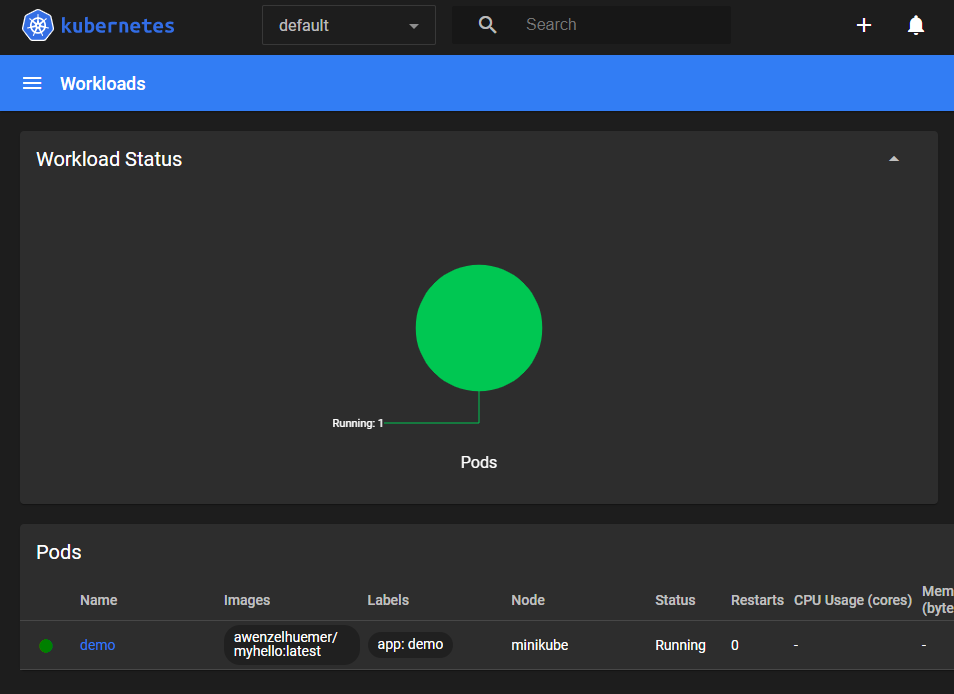- Install Minikube on your computer
minikube start- Open the minikube dashboard
minikube dashboard- Run container in kubernetes
kubectl run demo --image=awenzelhuemer/myhello:latest --port=5000 --labels=app=demo- Verify that container started
kubectl get pods --selector app=demoResult:
NAME READY STATUS RESTARTS AGE
demo 1/1 Running 0 3m25s
- Forward local port 9999 to the container port 5000
kubectl port-forward demo 9999:5000Result:
Forwarding from 127.0.0.1:9999 -> 8888
Forwarding from [::1]:9999 -> 8888
Handling connection for 9999
Application which runs on port 8888 gets redirect to local port 9999.
- Delete the pod
kubectl delete pod demoResult:
pod "demo" deleted
- Apply the deployment to your Kubernetes cluster
kubectl apply -f deployment.ymlResult:
deployment.apps/demo created
- See active deployments
kubectl get deploymentsResult:
kubectl get deployments
- Get more information on the demo deployment
kubectl describe deployment demoResult:
Name: demo
Namespace: default
CreationTimestamp: Tue, 09 May 2023 13:44:11 +0200
Labels: <none>
Annotations: deployment.kubernetes.io/revision: 1
Selector: app=demo
Replicas: 1 desired | 1 updated | 1 total | 1 available | 0 unavailable
StrategyType: RollingUpdate
MinReadySeconds: 0
RollingUpdateStrategy: 25% max unavailable, 25% max surge
Pod Template:
Labels: app=demo
Containers:
demo:
Image: awenzelhuemer/myhello:latest
Port: 80/TCP
Host Port: 0/TCP
Environment: <none>
Mounts: <none>
Volumes: <none>
Conditions:
Type Status Reason
---- ------ ------
Available True MinimumReplicasAvailable
Progressing True NewReplicaSetAvailable
OldReplicaSets: <none>
NewReplicaSet: demo-57fd987b7b (1/1 replicas created)
Events:
Type Reason Age From Message
---- ------ ---- ---- -------
Normal ScalingReplicaSet 25s deployment-controller Scaled up replica set demo-57fd987b7b to 1
- Forward local port 9999 to the container port 8888
kubectl port-forward deployment/demo 9999:8888- Query the pods of your deployment with
kubectl get podsResult:
NAME READY STATUS RESTARTS AGE
demo-57fd987b7b-f98tw 1/1 Running 0 7m39s
- Delete the pod
kubectl delete pod --selector app=demoResult:
pod "demo-57fd987b7b-f98tw" deleted
- Query again
kubectl get podsResult:
Replica set is still running
NAME READY STATUS RESTARTS AGE
demo-57fd987b7b-8ks2w 1/1 Running 0 59s
- Apply the service to your Kubernetes cluster
kubectl apply -f service.ymlResult:
service/demo created
- Describe service
kubectl describe service demoResult:
Name: demo
Namespace: default
Labels: <none>
Annotations: <none>
Selector: app=demo
Type: LoadBalancer
IP Family Policy: SingleStack
IP Families: IPv4
IP: 10.96.231.25
IPs: 10.96.231.25
LoadBalancer Ingress: 127.0.0.1
Port: <unset> 80/TCP
TargetPort: 8888/TCP
NodePort: <unset> 32199/TCP
Endpoints: 10.244.0.9:8888
Session Affinity: None
External Traffic Policy: Cluster
Events: <none>
- Start tunnel
minikube tunnel✅ Tunnel erfolgreich gestartet
📌 ACHTUNG: Schließen Sie dieses Terminal nicht. Der Prozess muss am Laufen bleiben, damit die Tunnels zugreifbar sind ...
❗ Access to ports below 1024 may fail on Windows with OpenSSH clients older than v8.1. For more information, see: https://minikube.sigs.k8s.io/docs/handbook/accessing/#access-to-ports-1024-on-windows-requires-root-permission
🏃 Start Tunnel für den Service demo
- Open application with LoadBalancer
Balancer Ingress: 127.0.0.1
- Apply namespace to your Kubernetes cluster
kubectl apply -f namespace.ymlResult:
namespace/demo-environment created
- Query namespaces
kubectl get namespacesResult:
NAME STATUS AGE
default Active 66m
demo-environment Active 59s
kube-node-lease Active 66m
kube-public Active 66m
kube-system Active 66m
kubernetes-dashboard Active 65m
- Apply deployment to namespace
apiVersion: apps/v1
kind: Deployment
metadata:
name: demo
namespace: demo-environment
spec:
replicas: 1
selector:
matchLabels:
app: demo
template:
metadata:
labels:
app: demo
spec:
containers:
- name: demo
image: awenzelhuemer/myhello:latest
ports:
- containerPort: 80- Apply the modified deployment
kubectl apply -f deployment.yml- Check resources in demo-environment
kubectl get deployments --namespace demo-environmentResult:
NAME READY UP-TO-DATE AVAILABLE AGE
demo 1/1 1 1 49s
kubectl get pods --namespace demo-environmentResult:
NAME READY STATUS RESTARTS AGE
demo-57fd987b7b-hjj2f 1/1 Running 0 58s


